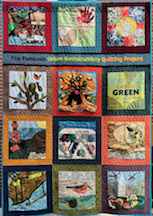
If You Breathe You Should Care
Files
Description
Many years ago, I worked in the Mott Haven section of the South Bronx providing social services to underserved populations. This was at the height of the HIV crisis in New York and this area was particularly affected because of the high rates of drug use. The families mostly hailed from Latin America, the Caribbean and Africa. However, they all had one thing in common, asthma. Almost every family had a child or an adult with asthma. We sought to address the high rates of asthma by helping families to find housing that was free of roaches, rats and mold. And when that failed, we took their landlords to court to force them to make the necessary repairs. After I left the job, I maintained communication with some of the families and colleagues who touched my life and whose life I became a part of.
My quilt draws attention to the environmental injustice in the South Bronx. One of the things I learned in subsequent years was that asthma is not only caused by mold and vermin infestation but by environmental inequality. Your ability to breathe clean air should not be determined by your zip code, the color of your skin or your socio-economic status. The area referred to as “asthma alley” is the 3rd poorest in the city and is 97 percent Latino and Black.
According to New York City community health profiles, the South Bronx has the highest levels of PM2.5, the most harmful air pollutant - 10.0 micrograms per cubic meter compared with 8.6 citywide. Other sources of air pollution include the excessive amounts of diesel-intensive industries that serve other communities. The Fresh Direct warehouse, and the printing press of The Wall Street Journal are both located in the South Bronx. Hunts Point Food Distribution center, the largest in the country, is also part of the steady stream of truck traffic. Although the area is home to only 6.5 percent of the population of the city, the South Bronx has one third of the city’s waste treatment plants.
Other sources of pollution include the exhaust fumes from a network of highways. There are ten highways running through the Bronx and four of those surround the South Bronx. In contrast there are only two highways running along the outskirts of Manhattan. This pollution causes asthma and other respiratory illnesses, leading to health complications and premature deaths for residents of the South Bronx. The asthma rate in the South Bronx is so high it was nicknamed asthma alley. The Guardian reported that asthma hospitalizations in the South Bronx are five times the national average and at rates 21 times higher than other NYC neighborhoods. Not surprisingly, city data also suggest that this area was among hardest hit by the coronavirus. Research confirmed that air pollution is associated with COVID-19 death.
Every New Yorker has a right to the city including equitable use of the services and resources that the city has to offer, participation in the decision making of how space is utilized and the right to a habitat that is clean, safe and life affirming. To achieve these goals, we need more equitable environmental regulations that offer protection for all forms of life in ways that ensure a responsible relationship between individuals and nature and promote the dignity and humanity of individuals, families and communities.
Publication Date
Spring 2023
Disciplines
Art and Design | Urban Studies and Planning
Recommended Citation
Daniel, Carol Ann, "If You Breathe You Should Care" (2023). The Flatbush Urban Sustainability Quilt, 2023. 8.
https://digitalcommons.liu.edu/community_usquilt_2023/8


